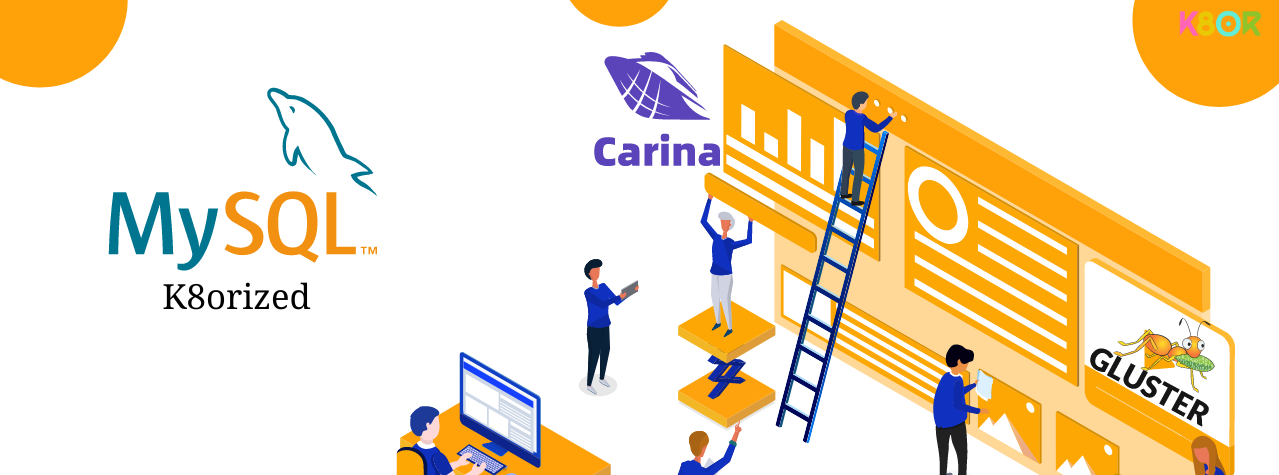By applying Level 3 k8orization techniques to your applications like MySQL, you can achieve significant performance improvements, resource efficiency gains, and enhanced security within your Kubernetes deployments. Imagine you're deploying a MySQL database instance within your Kubernetes cluster. Level 3 k8orization can refine and optimize it for enhanced performance, security, and resource efficiency.The follwoing process requires MySQL expert knowledge and not recommened for everyone and it may vary from OS to OS, and MySQL version.
Standard MySQL Container:
-
Official MySQL Docker image with default configuration.
-
Includes all features and functionalities, even those not required for your specific use case.
-
Potential for unnecessary resource consumption and security vulnerabilities.
k8orized MySQL Deployment (Level 3):
-
Configuration Optimization:Tune MySQL configuration files (e.g., my.cnf) to match your specific workload requirements. This might involve adjusting memory allocation, buffer sizes, and query settings. -
Feature Removal:If certain features (e.g., replication, full-text search) are not needed, disable them to reduce the image size and resource footprint. -
Security Hardening:Implement security best practices like setting strong passwords for root and application users, disabling unused network interfaces, and utilizing security contexts within the Pod definition. -
Resource Capping:Define resource limits and requests for the Pod running MySQL, ensuring predictable resource utilization within your cluster.
Benefits:
-
Improved Performance:Tailored configuration can optimize MySQL for your specific workload, leading to faster queries and better responsiveness. -
Reduced Resource Consumption:Removing unused features and optimizing settings minimize CPU, memory, and storage usage. -
Enhanced Security:Security hardening measures reduce the attack surface and potential vulnerabilities. -
Simplified Management:Consistent configurations across deployments streamline maintenance and security updates.
Additional Considerations:
-
Application-Specific Optimization:Analyze your specific MySQL usage patterns and adjust the k8orization strategies accordingly. -
Monitoring and Logging:Integrate monitoring tools and enable detailed logging to track performance and identify potential issues. -
High Availability and Scaling:Consider using additional tools and configurations for high availability and horizontal scaling of your MySQL deployment within Kubernetes.
Remember, Level 3 k8orization focuses on optimizing individual applications within your cluster. For further granular control and optimization of individual microservices within an application, Level 4 k8orization comes into play, which we can explore later.
1. Custom Image:
-
Instead of using the official MySQL image directly, create a custom image containing only the required components. This could involve building from scratch or using tools like Dockerfile instructions to selectively include specific libraries and binaries needed for your desired functionality.
-
This approach offers maximum control and minimizes image size, and requires effort and expertise.
2. Configuration-Based Optimization:
-
While directly disabling features within the container might not be possible, you can achieve similar results through configuration adjustments. For example, disabling replication options in MySQL configuration files effectively removes that functionality without modifying the image itself.
-
This approach is less invasive but might not always offer the same level of granularity or resource reduction as a custom image.
-
In certain cases, consider using separate sidecar containers for specific functionalities like full-text search instead of including them within the main MySQL container. This modular approach isolates concerns and allows independent scaling or removal of features as needed.
-
This adds complexity to your deployment but can offer flexibility and resource efficiency gains, especially for features used infrequently.
4. Alternative Solutions:
-
Explore alternative open-source or commercial MySQL distributions specifically designed for resource efficiency and specific use cases. These distributions might already have features selectively removed or provide customization options to achieve the desired functionality with a smaller footprint.
-
This can be a quicker solution if existing options align with your needs, but might limit flexibility compared to building your own image.
Overall, while directly disabling features within standard Docker images might not be straightforward, Level 3 k8orization provides alternative strategies like custom images, configuration optimization, sidecar containers, and alternative solutions to achieve similar results for reducing the resource footprint and optimizing your MySQL deployment within Kubernetes.
The optimal approach depends on your specific needs, expertise, and desired level of control. Choose the method that best balances efficiency, security, and maintainability for your application within your K8s environment.
This document presents an example hGraph visualization of the application k8orization process implemented at BOTops company.
The user authorization process requires accessing and verifying credentials across all necessary services: Google, AWS, Jira, Miro, Toggle Tracker, GitHub, and DockerHub.
This sector outlines the creation of manifest files in YAML format for various Kubernetes resources.
-
The first manifest defines a StorageClass, enabling volume creation.
-
The second manifest creates a PersistentVolumeClaim, claiming a volume.
-
The third manifest deploys a service with mounted volumes, exposing both /mnt and /usr directories.
-
The fourth manifest deploys another service with mounted volumes, focusing specifically on volumes within the /usr directory.
Section 3 outlines the pre-deployment steps, including authorizing access to a Jump EC2 instance, establishing a connection to the EKS cluster, switching to the appropriate namespace, and verifying connectivity to the Node Group, ensuring a smooth and secure deployment process.
Section 4 dives into deploying the StorageClass, detailing the steps: uploading the manifest file, establishing the StorageClass itself, and the subsequent automatic volume creation, streamlining storage provisioning for your application.
Section 5 outlines the deployment of the PersistentVolumeClaim (PVC), guiding you through uploading the manifest file and subsequent PVC creation. This empowers your application to request and utilize persistent storage seamlessly.
Section 6 delves into the deployment process, guiding you through applying the deployment manifest, creating the deployment resource, spawning a replica set, and finally launching individual pods, orchestrating the entire application rollout in a step-by-step manner.
Section 7 tackles automated pod storage attachment, demonstrating how to specify StorageClass and PersistentVolumeClaim information within your manifest file. This ensures seamless storage provisioning for your deployed pods.
Section 8 dives into content migration, guiding you through executing the created pod, copying all files from /usr to the mounted /mnt directory, and then verifying memory usage remains consistent across both directories. This final step confirms successful migration and data persistence within the mounted volume.
Sector 9 streamlines resource removal with the deployment manifest deletion, triggering a cascading process that automatically deletes the associated pods, replica set, and ultimately the deployment itself.
Section 10 showcases deployment with a dedicated volume for the /usr directory. It walks you through applying a deployment manifest, spawning a replica set, and launching individual pods, all configured with the mounted volume.
Sector 11 focuses on automated storage provisioning for deployed pods. This triggers the automatic attachment of the storage resources to the created pod.
This section describes the installation process for the Streamlit application. It includes the steps involved in setting up the Streamlit environment and any required dependencies. Additionally, it highlights the generation of a log file to track the installation process and potential issues.
Looking to expand your k8or knowledge?
k8or is easier to use with a basic understanding of Kubernetes principles and core concepts. Learn and apply fundamental k8or practices to run your application in k8or.

Explore BLOCK framework, k8orization, custom images, deployments, and more



